
Rechargeable batteries have promoted progress and boosted the acceptance of portable equipment such as mobile phones, palmtops and notebooks. Their service life largely depends on a defined charging procedure in which charging current matches temperature. This is particularly true of rapid recharging.
Nickel cadmium batteries have been used in mobile phones since 1993. They were superseded by more powerful nickel metal hydride batteries in 1995 and more recently by lithium ion batteries. Lithium polymer batteries, which offer a better weight/volume to performance ratio than nickel-based solutions, are the latest development. The higher energy density of lithium-based systems will certainly make them more attractive in future.

These circuits must be matched to the various battery systems, especially to low and high charging and operating temperatures. Conventional NiCd batteries are more tolerant of charging at extreme temperatures than metal hydride or lithium ion batteries. An overview of the permissible temperature ranges for slow and rapid charging is given in Table 1. The charging requirements of the various rechargeable batteries are shown in Table 2. Among the various mechanisms used to protect them, temperature monitoring circuits in general and electronic components with negative temperature coefficients in particular, such as NTC thermistors, play a prominent part. NTC thermistors monitor the cell temperature; used in an intelligent protection circuit, they can prevent an undesired temperature rise caused by excessive current. In conjunction with voltage measurements, they can also monitor the level of the battery charge. NTC thermistors monitor upper and lower limit temperatures for rapid charging, especially of lithium ion batteries. Temperature-controlled charging increases the number of charging and discharging cycles possible (Graph 1), enhances safety and makes full use of battery capacity. Various methods are available for monitoring the temperature of the charging process.
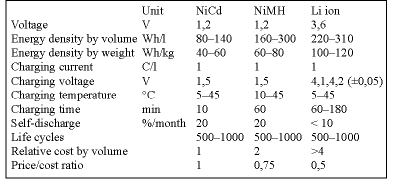
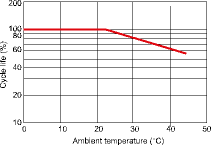
Charging of nickel cadmium and nickel metal hydride batteries
Normal, slow charging can be done with a constant charging current over a predetermined period. The charging current then corresponds to 10% of the rated charging capacity (0,1 C). A timer ends the charging process. In rapid charging, a higher charging current, corresponding to charging capacity 1 C, is required. A distinction between temperature and voltage modes is made. In voltage modes (Graph 2), parameters measured include the maximum charging voltage Vmax, the final charging voltage when the voltage rise as a function of time is zero, or a negative voltage drop - V after the maximum charging voltage has been reached. The limit and cell temperatures of the NTC thermistor are also monitored, as the cell temperature directly affects the cutoff time of the charging current and thus the result of charging. Without temperature monitoring, the charging current is not switched off when a hot battery is charged, and if the cutoff time is defined only by the maximum charging voltage, the battery overloads to the point of thermal destruction.
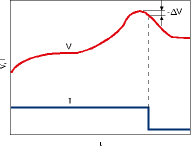
In temperature modes (Graph 3), the absolute value Tmax, the difference T from the initial temperature or the gradient dT/dt during charging is measured. In the gradient process, the rate of temperature rise is monitored. The value of dT/dt should be selected as a function of temperature to prevent premature cutoff when charging starts. In intelligent charging techniques, the gradient process is often used in conjunction with additional monitoring of the maximum final temperature. Typical cutoff values selected for charging are a dT/dt value of 1°C/min for the temperature rise and a maximum temperature of 60°C for the temperature limit.
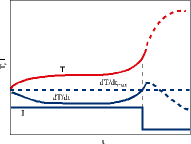
Charging of lithium ion batteries
The external charging conditions must be checked before a typical charging cycle. If the temperature is outside the limits specified by the manufacturer (below 5°C or above 45°C), charging is prohibited for safety reasons. If the voltage is below its specified minimum, trickle charging starts until the limit for rapid charging is reached. Lithium-based batteries cannot be charged rapidly with constant current control, as this method recovers only about 70% of the previous charge possible. The battery is fully charged by constant current charging followed by constant voltage charging (Graph 4). The constant voltage must not fluctuate by more than ±1% to ensure that the battery is charged to full capacity without being destroyed. As higher charging voltages lead to higher charging capacities, battery manufacturers are well advised to use maximum charging voltages without compromising battery safety. However, the usable charging voltage is determined by the external temperature. Because lithium ion batteries contain separable and explosive substances, they are protected by a complex safety circuit with an NTC thermistor which initiates cutoff at excessively high temperature. An overall solution based on ICs in conjunction with NTC thermistors is often selected for lithium ion batteries.
For these applications, EPCOS has developed a new series of NTC thermistors as SMDs in sizes 0402, 0603 and 0805 that cover a wide resistance range from 47 to 680 kOhm. These high-precision temperature sensors are available with an accuracy finer than ±1°C in the relevant temperature range from 5 to 45°C, which permits precise temperature monitoring of the battery. The terminals of the new SMD series are manufactured with nickel barrier metallisation. The superior wettability and solderability of this metallisation make the new thermistors easier to process than components with conventional silver palladium metallisation, especially in conjunction with the low solder temperatures possible in reflow soldering. In developing these new SMD NTC thermistors in multilayer technology, Epcos has drawn on synergies and decades of experience in ceramic components. Multilayer technology with internal electrodes ensures high temperature stability, low resistance drift (less than 1%) during soldering, and high long-term stability in operation.
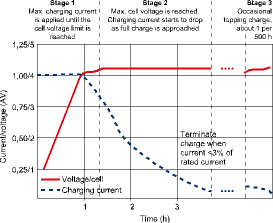
Summary
The following properties make NTC thermistors from Epcos ideal for temperature monitoring in rechargeable battery systems: High, long-term stability; low resistance drift; precise temperature measurement thanks to various characteristics; very wide range of components in SMD sizes 0402, 0603, and 0805 with resistances from 47 to 680 kOhm; easier processing even at low solder temperatures (reflow soldering) thanks to nickel barrier metallisation; customer-specific and application-specific variants can be implemented.
| Tel: | +27 11 458 9000 |
| Email: | [email protected] |
| www: | www.electrocomp.co.za |
| Articles: | More information and articles about Electrocomp |

© Technews Publishing (Pty) Ltd | All Rights Reserved